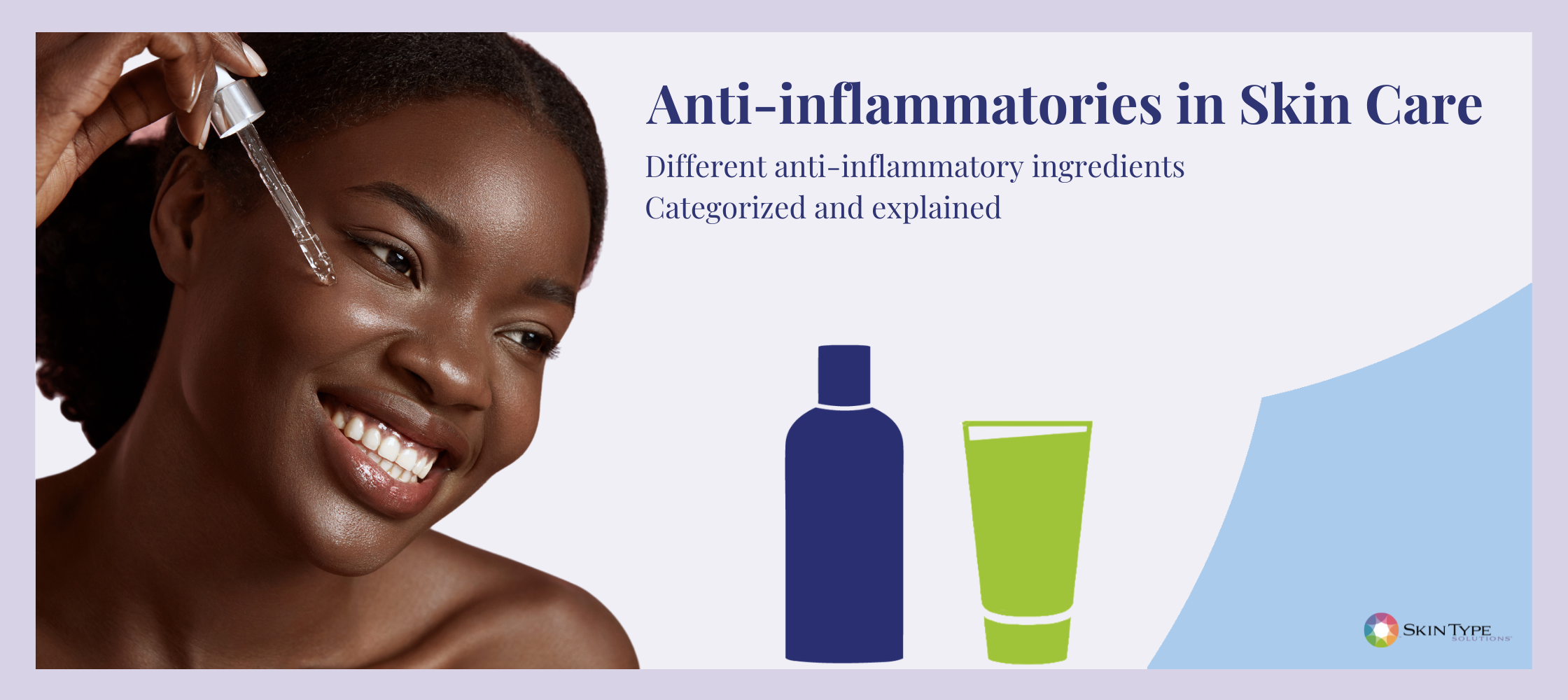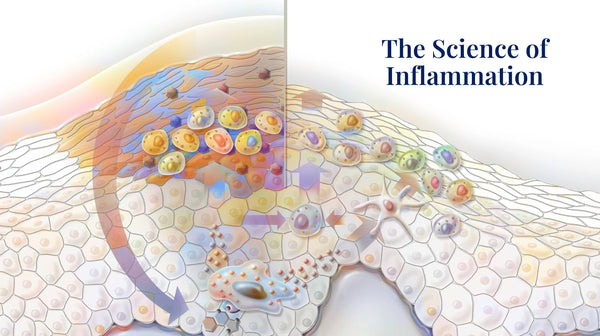Anti-Inflammatory Ingredient Dictionary
There are many ingredients in skin care meant to soothe and calm the skin. These anti-redness ingredients can be found in cleansers, toners, serums, and creams; however, they work best in leave on redness reducing products like anti-redness creams and serums.
This blog has a list of anti-redness soothing ingredients. You can click on the name of the anti-inflammatory ingredient and learn more about that ingredient and see the evidence- based research behind how these soothing and calming ingredients work.
To learn more about skin inflammation and the scientific pathways that cause skin redness, follow these links.
Anti-inflammatory skin care ingredients work by turning off immune system signals that otherwise "turn on" inflammation.
There are many different anti-inflammatory ingredients. The best ones for you depend on your skin type and specific concern.
Allantoin and niacinamide are two of the most popular anti-redness ingredients in skin care.
Table of contents

Complete List of Anti-Redness Skin Care Ingredients
Skin care products to treat sensitive skin are very popular. It is hard to know which to choose. One way to evaluate which is best is to see which anti-inflammatory ingredients they have. You can look on the product label. Our skin type quiz can help you find the best anti-redness products for your skin type- but you still might be interested in learning about the ingredients these soothing product contain.
Here is a list of all the anti-inflammatory ingredients in skin care products. Click on the soothing ingredient in the list below to learn the science behind these ingredients.
- Allantoin
- Almond oil
- Aloe Vera
- Argan Oil
- Artemisia capillaris
- Bisabolol
- Caffeine
- Camellia Sinensis Leaf Extract
- Camellia Japonica seed oil
- Caproloyl Salicylic Acid
- Chamomile
- Crepidiastrum Denticulatum Extract- also called Pollux CD
- Cucumber
- Evening primrose oil
- Fever few
- Gallic Acid
- Glycine Soja Oil
- Glycyrrhiza glabra
- Grapeseed Oil
- Licorice Extract
- Linoleic acid
- Macadamia Nut Oil
- Niacinamide
- Panthenol
- Polyphenols
- Portuaca Oleracea Extract
- Resveratrol
- Salicylic acid
- Safflower oil
- Sunflower oil
- Saururus chinensis also called Asian Lizard's Tail Plant or Chinese Lizard's Tail
- Selenium
- Sulfur
- Tetrhydrodiferuloylmethane
- Ulmus Davidiana
- Vaccinium myrtillus
- Vitamin B5
- Silybum marianum
- Sunflower seed oil
- Zinc

What Causes Skin Redness?
Inflammation in the skin is caused by many different pathways that get turned on in the skin. These inflammatory pathways are driven by cell signaling and are very difficult to turn off. It is best to prevent skin inflammation when possible.
Sensitive skin types are more susceptible to inflammation and should use soothing, calming anti-inflammatory skincare ingredients in their skin care products.
The wrong skin care routine can cause skin redness.
Make sure the products you are using are right for your Baumann Skin Type.
What Skin Concerns Do Anti-Inflammatory Ingredients Treat?
Any anti-inflammatory ingredients can calm and soothe skin redness. Which is right for you depends upon what skin problems you have that are causing your skin to be sensitive.
Anti-inflammatory ingredients can be used to treat these causes of skin redness:
- Acne
- Allergy
- Burns
- Eczema
- Heat rash
- Psoriasis
- Rashes
- Retinoid dermatitis
- Rosacea
- Skin after cosmetic procedures like Botox and fillers
- Skin irritation
- Sunburn
- Sun sensitivity
Take our skin type quiz to find out what anti-redness products to choose.
Top 10 Anti-Inflammatory Ingredients in Skin Care Products
There are many anti-inflammatory ingredients to treat skin redness. However, allantoin and niacinamide are the most popular. Here are the top 10 soothing ingredients to calm skin redness found in skin care products. Keep in mind that depending on your skin type, the best ingredients for you can vary.
Click on the ingredient to learn more.
- Allantoin
- Argan oil
- Artemisia capillaris
- Azelaic acid
- Bisabolol
- Caffeine
- Fever few
- Glycyrrhetinic acid (licorice extract)
- Green tea
- Niacinamide

How Do Anti-Inflammatory Ingredients Get Rid of Skin Redness?
Soothing ingredients calm skin inflammation. They do this by turning off the immune system signals that are causing inflammation. They may block histamine release, decrease blood flow to the area by constricting blood vessels, or neutralize free radicals or other signals causing the immune system to react.
Best Anti-Redness Ingredients to Treat Rosacea
Rosacea is a skin disorder that causes the face to turn red and flush. Rosacea suffers need a specific skin care routine. These are the types of ingredients that are used in rosacea creams and serums in rosacea skin care routines.
These ingredients are not as good in rosacea cleansers because the contact time is too short for them to have much of an effect.
What Ingredients Help Acne Redness?
Salicylic acid is the best ingredient to treat acne redness. It is found in many acne treatments. However, it can dry the skin, so you should combine salicylic acid with other soothing anti-inflammatory ingredients.
Salicylic acid is the best anti-inflammatory ingredient for acne because it:
- is in the salicylate (aspirin) family.
- is anti-inflammatory.
- is a BHA, so it can unclog pores.
- lowers skin pH to keep away acne causing bacteria.
- is an exfoliant.
- helps regulate desquamation.
These are some of our favorite anti-inflammatory products with salicylic acid to treat acne:
What Are the Best Anti-Inflammatory Ingredients for Your Skin Type?
Which antiaging ingredients are best for you depends upon your Baumann Skin Type.
Once you know your Baumann Skin Type, you can shop by your skin type and find the best products for your skin. Using the wrong skin care products for your skin type can cause skin inflammation, so make sure you follow our dermatologist recommended skin care routines and suggestions and shop by your Baumann Skin Type.

Best References on Anti-Inflammatory and Anti-Redness Skin Care Ingredients:
- Baumann L. Ch. 38 Anti-inflammatory Ingredients in Baumann's Cosmetic Dermatology 3rd ed. (McGraw Hill 2022)
- Baumann L. Ch. 64-74 in Cosmeceuticals and Cosmetic Ingredients (McGraw Hill 2015)
- Wu, J. (2008). Anti-inflammatory ingredients. Journal of drugs in dermatology: JDD, 7(7 Suppl), s13-6.
- Costa, A., Eberlin, S., J Polettini, A., F da Costa Pereira, A., S Pereira, C., M Cortes Ferreira, N., ... & B Oliveira Torloni, L. (2014). Neuromodulatory and anti-inflammatory ingredient for sensitive skin: in vitro assessment. Inflammation & Allergy-Drug Targets (Formerly Current Drug Targets-Inflammation & Allergy)(Discontinued), 13(3), 191-198.
- Ferreira, M. S., Sousa Lobo, J. M., & Almeida, I. F. (2022). Sensitive skin: Active ingredients on the spotlight. International Journal of Cosmetic Science, 44(1), 56-73.
- Silva, D., Ferreira, M. S., Sousa-Lobo, J. M., Cruz, M. T., & Almeida, I. F. (2021). Anti-inflammatory activity of Calendula officinalis L. Flower extract. Cosmetics, 8(2), 31.















































